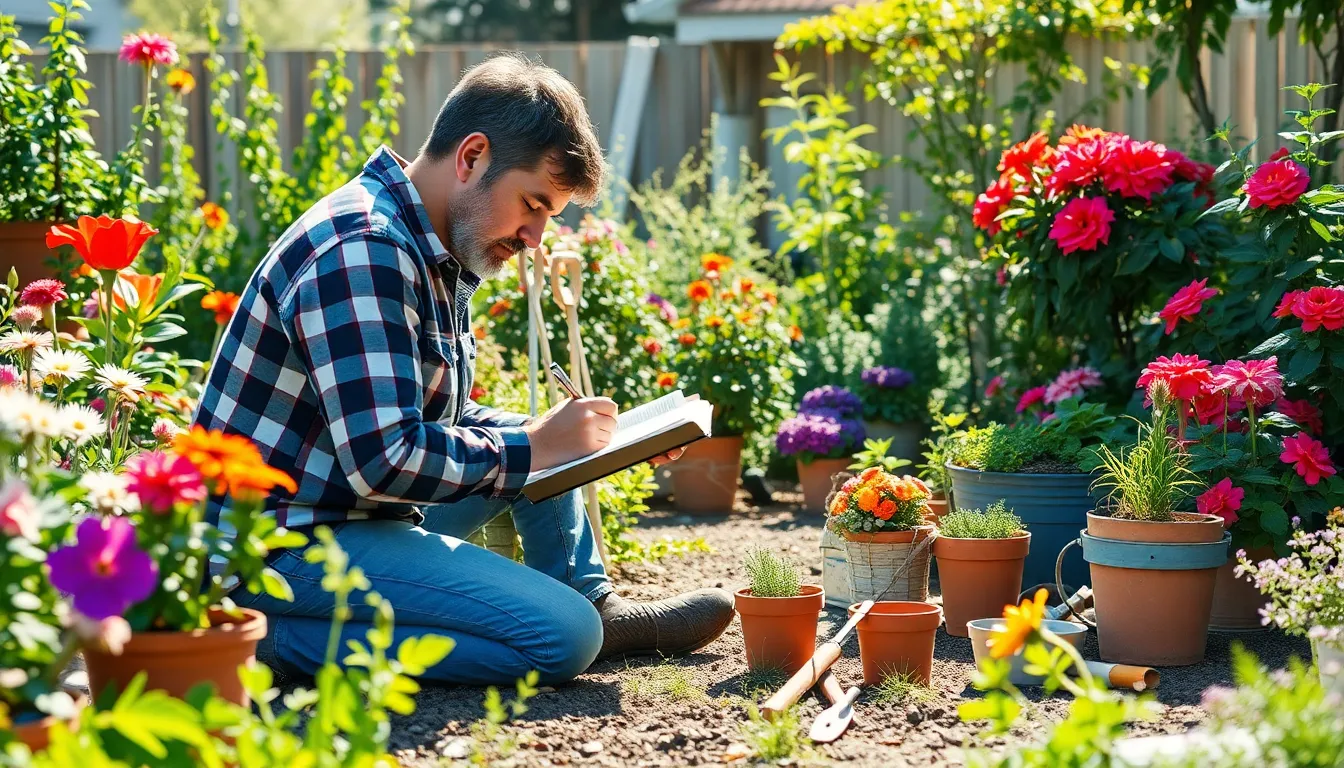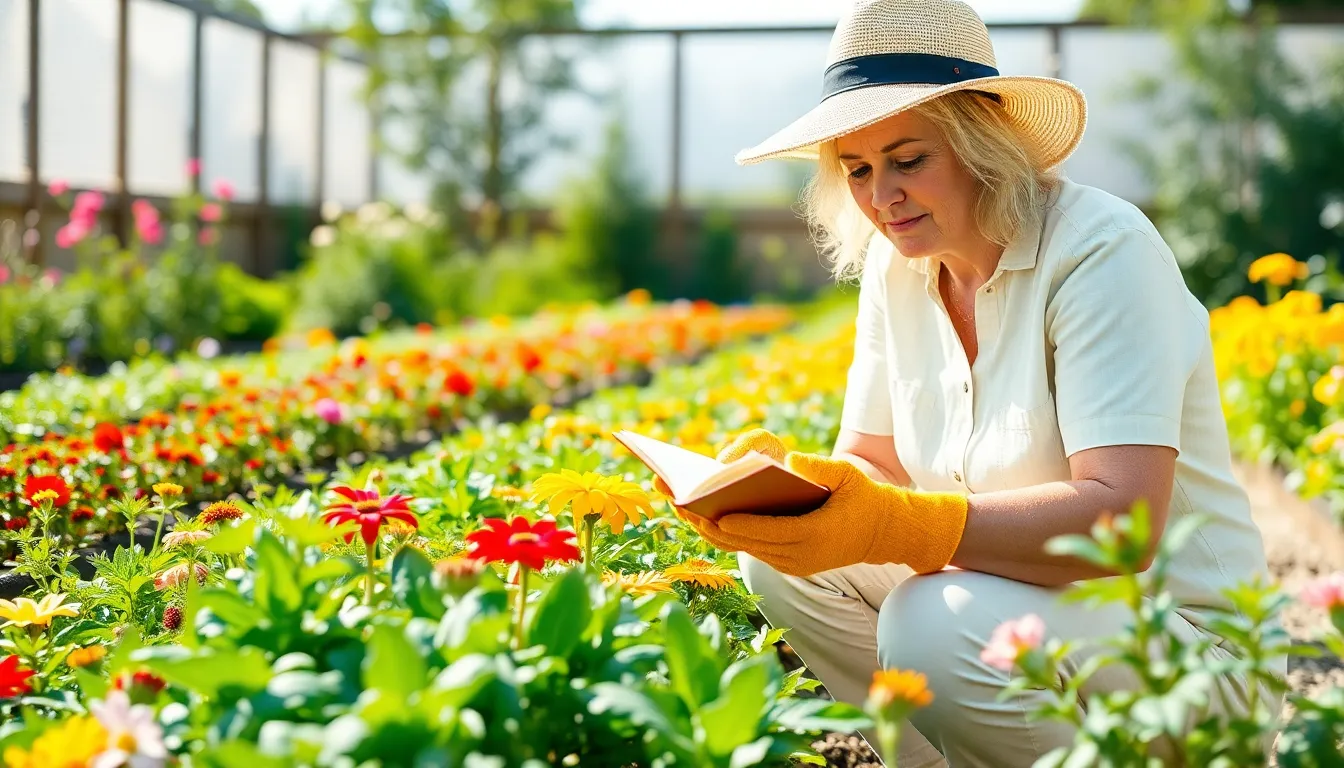Imagine stepping into your garden and knowing exactly what to do, when to do it, and how to make your plants thrive. Sounds dreamy, right? Enter the gardening journal—the unsung hero of green thumbs everywhere. This little book isn’t just a place to doodle your plant dreams; it’s a powerful tool that can turn even the most chaotic garden into a flourishing paradise.
Table of Contents
ToggleWhat Is a Gardening Journal?
A gardening journal serves as a comprehensive record for gardeners. This tool allows users to document plant growth, track seasonal changes, and note successful techniques. Organizing information maximizes efficiency and promotes better gardening practices.
Gardeners can log planting dates and varieties, ensuring they can replicate successful strategies in future seasons. Photos capture the progression of growth, making it easy to identify what worked well. Additionally, tracking weather patterns helps gardeners anticipate challenges and adjust care accordingly.
A well-maintained gardening journal can enhance the gardener’s understanding of their unique environment. Noting pest occurrences and their management leads to improved strategies, ultimately resulting in healthier plants. Recording lessons learned fosters growth in gardening expertise over time.
Different formats exist for gardening journals. Some opt for traditional handwritten entries, while others prefer digital tools that offer easy editing and cloud storage. The choice typically depends on personal preference and the level of detail desired.
Ultimately, the journaling process creates a reference point for adhering to effective gardening practices. By reviewing prior entries, gardeners can make informed decisions for ongoing cultivation. Enhanced organization and reflection drive success in achieving garden goals.
Benefits of Keeping a Gardening Journal

Maintaining a gardening journal offers numerous advantages that significantly improve gardening practices.
Tracking Plant Growth
Tracking plant growth provides essential insights into the development of each garden element. A gardener can log planting dates to monitor time frames for growth stages. By noting flowering times, vegetable yields, and health indicators, they gain a clearer understanding of growth patterns. Each entry reflects unique variations among plant varieties, allowing for precise comparisons. Whether it’s recording how certain plants thrive under specific conditions or identifying effective fertilization techniques, detailed records enhance overall strategies. Photos documenting growth milestones contribute visual references that enrich learning and adjustment processes.
Recording Seasonal Changes
Recording seasonal changes plays a crucial role in gardening success. Gardeners can pinpoint the timing of seasonal shifts, which aids in scheduling planting and harvesting effectively. By documenting weather conditions such as temperature fluctuations and rainfall amounts, a gardener discovers patterns that impact plant health. Noting pest occurrences and periods of dormancy enhances knowledge of seasonal challenges. Each seasonal record serves not only as a reference for future planning but also helps in adjusting gardening practices to better align with environmental changes. Tracking these shifts fosters a deeper connection to the gardening cycle, cultivating a more responsive and thriving garden.
How to Start Your Gardening Journal
Starting a gardening journal requires clarity on format and content. This tool helps gardeners monitor growth and refine strategies effectively.
Choosing the Right Format
Selecting the right format is essential for consistency and ease of use. Traditional handwritten journals offer a tactile experience, allowing the gardener to doodle and annotate freely. Digital formats, such as apps or spreadsheets, enable easy organization and quick edits. Many people prefer a combination, using a digital platform for ease and printing pages for a tactile feel. Identifying personal preferences guides the choice of format, ensuring greater engagement.
Essential Information to Include
Including essential information boosts the journal’s effectiveness. Documenting planting dates provides a timeline for future reference. Each plant’s type and location within the garden should also be noted for context. Weather conditions, including rainfall and temperature, influence growth patterns, so logging these helps anticipate challenges. Record pest occurrences and management strategies, as this insight informs future practices. Photographic evidence of growth stages adds a visual element that enhances learning. This combination of details promotes a comprehensive understanding of gardening successes and challenges.
Tips for Maintaining Your Gardening Journal
Maintaining a gardening journal involves thoughtful practices that enhance its effectiveness and personal relevance. Consider these suggestions to maximize the benefits of your journal.
Consistency is Key
Consistency ensures that garden records remain reliable and informative. Regular entries maintain a clear timeline, allowing for an accurate assessment of growth patterns. Log daily or weekly activities to track progress effectively. Make recording a routine, such as after watering or when observing changes. By adhering to a set schedule, gardeners draw connections between their activities and plant health, promoting proactive care. Use this consistent habit to notice trends that arise throughout the seasons, allowing for informed decisions in future plantings.
Creative Ways to Personalize Your Journal
Personalization adds a unique touch to a gardening journal, making it more engaging. Use colored pens, stickers, or drawings to highlight significant entries. Incorporate photographs to visually document growth stages or changes in the garden’s landscape. Design sections for specific plants, allowing for individualized attention and insights. Adding inspirational quotes can motivate gardeners through challenging seasons. Include notes on personal experiences to create a storytelling element within the journal. By customizing each page, it’s easier to reflect on past successes and challenges while cultivating a deeper emotional connection to the gardening journey.
A gardening journal is more than just a notebook; it’s a powerful ally in the quest for a thriving garden. By documenting essential details and reflecting on experiences, gardeners can foster a deeper connection to their plants and the natural world. This organized approach not only enhances the gardening process but also allows for informed decision-making in future seasons.
Whether opting for a traditional format or a digital tool, maintaining a gardening journal encourages consistency and creativity. Personalizing the journal makes the gardening journey even more enjoyable. With each entry, gardeners can celebrate their successes and learn from their challenges, ultimately cultivating a flourishing garden that brings joy and satisfaction.



